- Photo by Yeager St. John
- Photo by Yeager St. John
- Photo by Yeager St. John
- Photo by Yeager St. John
- Photo by Yeager St. John
- Photo by Yeager St. John
- Photo by Max Cooper
- Photo by Max Cooper
- Photo by Yeager St. John
- Photo by Yeager St. John
Asheville murals have as many purposes and placements as they do colors and subjects. They serve as advertisements and art, historical documents and decorations for dozens of buildings across our city.
It seems like a new mural goes up every few weeks, and we can expect many more to come. Gabriel Shaffer has been working on a mural inside the Asheville Art Museum. Molly Must is planning a piece for Triangle Park on Market Street. Ian Wilkinson has several projects going with the Asheville City Schools. And Wilson Alley, next to Eagle Street, is getting a mural by Molly Rose Freeman.
The artists have motives that differ and sometimes compete with one another. Some make political comments, others aim to preserve and document history and a few artists just hate blank walls. Some work alone, some act as muralist enclaves in our city and abroad.
On the other side of the wall, business and building owners commission works to serve a variety of needs. Murals can be ads, they can beautify and tell a story of what businesses do, or what others have done with their building walls.
We chose a few of the painters and businesses that show the diversity of Asheville’s mural scene — one that continues to grow.
Sims Futon Gallery (downtown Asheville)
“Believe it or not, Asheville was probably more eccentric 20 years ago than it is today,” says Richard Sims of Sims Futon Gallery. The store’s downtown location has helped foster many strange and wonderful relationships during the past 17 years, Sims says. In the mid-‘90s, artist Scott Herring (now a professor at UC Berkley in California) came into Sims’ store proposing to paint a mural on the side of the building.
“He was intrigued by the empty wall,” Sims says. “It was a blank canvas for him.”
Herring’s enthusiasm and sense of humor and budget proposal (along with his budget proposal) convinced Sims. “He was quite the character,” says Sims. “At one point he had named half the pigeons downtown.”
Inspired by the Sims’ love of animals, Herring created a boisterous, vintage comic book-inspired mural. At one point, the Sims family had 12 dogs, several horses and a donkey living on their property just outside of Asheville.
“We definitely wanted to get all of our critters up there,” Sims says.
Standing outside looking at the mural one foggy January afternoon, Sims kept one eye on a conversation between a city police officer, a homeless man and the homeless man’s dog. Assured that all was well with the man and his best friend, Sims began to describe the first scene, “Dog Days.”
In this first panel, several of Sims’ dogs burst out of the flattened space behind them, careening after a witty hare into the lower-right corner of the scene. Donning a checkerboard coat, the hare declares, “Better checks than hounds-tooth.” Happy with the first panel, Sims invited Herring to work his way across the wall. Throughout 1995, Herring returned with fresh ideas.
The next panel takes cues from the gadgetry of American cartoonist Rube Goldberg. Against a vibrating background of shimmering color, a sinuous man clambers up a Seussville-type outcropping. This is no stock character; this is Lawrence, a former employee and avid rock climber. As Lawrence climbs, the sun above beams down on his bald head. A chain-reaction is set in motion. Lacrosse balls are lobbed by the Sims’ nephew, Jared, balloons stir and clams and termites awaken, prompting a cat, eager for the taste of tuna, to trigger a bucket of green goo to dump over Lawrence’s head.
The third tells the story of a homeless woman named Mary and her devotion to her dog named Dog. One cold night, not wanting to leave Dog unattended, Mary chose not to enter a shelter. That night Mary died with Dog by her side, Dog was later adopted. Sims and Herring chose to honor Mary’s life, her boyfriend and her dedication to Dog in the third panel of the mural where Dog plays a washtub basin that’s printed with the words “T.Lee loves Mary.”
Sims Futon Gallery is at 109 Patton Ave. in downtown Asheville.
Dustin Spagnola
“They’re not murals,” Dustin Spagnola says. Spagnola’s pieces have been popping up on buildings all over town, but he calls them “large-scale public works,” a “middle ground between graffiti and corporate advertising.” They often tackle a single topic or portray one person within a tight range of color, usually black and white.
The Lexington Avenue Gateway is the type of mural you stop and look at for a while. Spagnola’s work is the kind that burns into your brain in seconds (hence the advertising aspect). The graffiti reference is thinly attached to the stock revolutionary figures he has put up in the past two years. His imagery is visually similar to Shepard Fairey-style wheat pastes and simplified graffiti forms, but otherwise, it could be called minimalism. And minimalism is effective in getting a point across.
While hanging his work in 2010 at the DeSoto Lounge, Spagnola asked about the patio wall out back. After getting the go-ahead, he painted his first pseudo-mural, a portrait of Mexican revolutionary Emiliano Zapata. From there he began painting around town. The Prospect invited him to paint a mural (this one, which features Marilyn Monroe, definitely is a mural) on the side of its wall. Spagnola combined a few film stills from 1961’s The Misfits.
He’s painted an image of Crazy Horse on Lexington Avenue, Bob Moog on Haywood Road and, more recently, the Bush and Obama mask painting, also on Lexington.
That painting, an image of President Bush holding a President Obama mask, is now on its third life cycle. It lasted for 24 hours at the Arcade, then a few weeks on Forever Tattoo. Back in December, during Art Basel, Spagnola traveled to Miami, where he painted the image on a 22-foot wall with an American flag background.
Spagnola’s met some harsh criticism for the simplicity, content and the method of his work (he paints using projected, borrowed images). The work is often temporary, and when one gets painted over, Spagnola considers it part of the process. He keeps it simple: “It’s not always about the talent; this work is about using a space to flex an idea.”
Ian Wilkinson
Asheville has experienced a surge of murals in the past six years, but can it handle more of them at this rate? When I asked Ian Wilkinson how much of Asheville’s mural space was full, suggesting we were at 5-or 10-percent capacity, he laughed. “More like 0.004 percent. Everything can be painted.”
Wilkinson is the fourth program director for the Asheville Mural Project (he took over from Molly Must in 2010). He moved from Sante Fe a little more than two years ago. Within a few months he met Must and began volunteering with AMP. In Sante Fe, during three-and-a-half years, Wilkinson worked on five murals. “Building owners were more concerned with keeping their adobe walls clean,” he said. In Asheville? Within two years, he has completed more than 25.
The relationship between murals and the community is growing stronger. Wilkinson recognizes the Lexington Bridge mural as a jumping-off point for the entire program — concrete proof of what the program can do. Most of the funding for AMP’s work comes through grants and other public sources. And despite the economy, there are still some private commissions.
Community support gives muralists like Wilkinson the momentum: If the community is there for him, he should be there for the community. “That’s what will sustain the art,” he says. So most of the murals AMP works on incorporate the buildings they are on or in. Murals de-institutionalize and bring life to vacant walls, he says.
“The outside needs to reflect the inside,” Wilkinson says. “Studios, businesses, neighborhoods and especially schools have so much more going on inside the walls. The public should know what’s going on.”
Chicken Alley (downtown Asheville)
Murals are a form of public storytelling for Molly Must. “In the beginning it was all about the opportunity to do something big,” she says of the Lexington Avenue Gateway Mural beneath the I-240 overpass. She spearheaded the project (including, at the tender age of 19, negotiating with the N.C. Department of Transportation) while serving as Asheville Mural Project’s third program director. The grand scale allows for a grand story, one that tells of past and present culture. So she considers her mural in Chicken Alley a smaller and more focused story about the alley and the north end of Lexington Avenue.
Must received a Regional Artists Project Grant through the Asheville Area Arts Council in 2010, and immediately began searching for mural space in Chicken Alley. It didn’t take long for building owner Chris McGrayne to agree.
Must began compiling a historical picture of the neighborhood, digging through old phone books and reaching out to former business and building owners and their descendants. She learned about a honeybee colony, a chicken house and a public freezer service used by residents to store the carcasses of hunted game. Must designed the mural with images from her research: chickens, honey jars and a snake named Boy.
Then, last fall, vandals hit the mural with a tag. It wasn’t just a little tag: it was 6-feet wide and 4-feet tall. Despite the alley’s level of graffiti coverage, Must didn’t put on a protective varnish. That’s changed. It took hours over the course of several days to remove the tag, which is still slightly visible up close. “I wanted to trust people,” Must says. “Now I realize that there are a lot of taggers out there who really can't find any meaning in craft.”
Cotton Mill Studios (River Arts District)
Arson destroyed most of the Asheville Cotton Mill in 1995, but artists have brought it back to life. Eileen and Marty Black bought the building in 2002 and converted what was left of it into the Cotton Mill Studios, a studio space for their pottery and 10 other artists.
The couple has long considered the River Arts District’s identity both a strength and weakness. Residents, artists and owners in the neighborhood have a close social connection. It’s a tight-knit community. But the buildings aren’t all connected, so they’re not easy for the public to navigate. There’s no significant signage, and no real gateway to the area that says “There’s art down here!”
“People need to know they’ve arrived,” Eileen says.
So Eileen and Marty had the River Arts District’s logo, a simple circular gear, painted on the building’s wall facing the I-240 bridge. Their newest addition is a trompe l’oeil mural by Ian Wilkinson that they hope will spur more murals in the district. They wanted a painting that would mesh with the building’s broken and fire-scarred look. Wilkinson mended and plastered over damaged areas, which also made for a level surface. He painted directly onto the wall.
Trompe l’oeil paintings trick viewers into seeing dimension in a space that doesn’t exist. Wilkinson “sank” an Atlas figure into the false space that seems to have been revealed because of fallen bricks. He even painted fake bricks. He situated the painting so it had the most realistic view when standing or sitting in a car — drivers usually stop and look, then eventually get out and take photos.
Says Eileen: “We wanted something to reflect the artwork going on inside of our building.”
Cotton Mill Studios is at 122 Riverside Drive.
Hunter Banks (Montford)
Hunter Banks Company has been at its Montford Avenue location since the mid-’90s, perched beside I-240. But until June of last year, you might not have noticed the fly-fishing store. Suddenly, a crew was mounting 60 feet of fish and water over the building’s entire south face.
The place needed a new look, says building and business owner Frank Smith.
Plus, he was spending hundreds of dollars every few weeks to remove or paint over graffiti tags. (The city has an ordinance that graffiti must be removed within 48 hours, or property owners get fined.) Smith says it was a “no-brainer.” A mural would ornament his building (and guard against graffiti) and double as the largest advertisement he’d buy for some time to come.
Smith put out a word-of-mouth proposal. There were no formal announcements, fliers or calls to artists. With the “I know somebody who knows somebody” network of Asheville, he figured something would turn up. And he was right. Asheville artists Jeremy Russell and Scott Allred approached him with sketches. A rainbow trout in a stream scene solidified the store’s identity. It also clued in Asheville residents and tourists alike to the fact that it’s a fly-fishing store, not a bank.
The artists used a marouflage method to paint and install the mural, hence its “overnight” appearance. Marouflage is a thousands-of-years-old painting technique that has recently found its way into the ranks of murals, through Los Angeles artist Kent Twitchell. Artists can paint on canvas material in the studio, then adhere it to a building. Once it’s up, artists can use a multitude of sun-blockers and weatherproof protective coatings that can make the mural last for decades.
Hunter Banks is at 29 Montford Ave.
Forever Tattoo
New work pops up frequently on the Hiawassee Street side of Forever Tattoo. The man behind this speedy street-art curation is Forever Tattoo owner and artist Rob Hunt.
The idea of showcasing local talent has been an interest of Hunt’s for quite some time. Hunt helped secure the wall in the old mill area next to the Hatchery in the River Arts District as a legal domain for graffiti artists. Last year, the old mill wall was off limits again, and Hunt’s wall began to play a more prominent role in showcasing Asheville’s street art talent.
Sometimes artists approach Hunt with sketches and mockups, but typically Hunt asks a friend to come down to the shop and paint something. Like most Asheville artists, Hunt is acquainted with the creative minds in town, including many anonymous street and graffiti artists. Some who’ve made it to the wall: Allen Hampton, Dustin Spagnola and Peter Parpan.
“It’s a pretty fluid operation,” says Hunt of his curatorial practice. If someone wants to paint the wall, though, it has to be quick, “If something takes a week or so to put up, it’s hardly worth the time, if the piece is going to be recycled in a month.”
Hunt notes that these works aren’t murals: “’Street art’ is the term.” This definition is partly due to the artists’ graffiti-art style and mostly to do with the works’ impermanence. Occasionally people are distressed when a piece disappears. But that’s how street art works. “How long the piece is up is relative to how good the piece is,” says Hunt.
Hunt admits that he doesn’t necessarily like all the works that make it onto the side of his building. But he puts his artistic preferences aside, and gives local street artists a legal space to exercise their artistry. It may be mediocre, it may be outstanding, but it won’t be boring.
Forever Tattoo is at 98 N. Lexington Ave.
Odyssey Center for Ceramic Arts (River Arts District)
Brian and Gail McCarthy built a wall for a mural at the Odyssey Center for Ceramic Arts in 2007. Flash forward three years and add the combined forces of ceramicist Kathy Triplett and studio resident Alex Irvine and you have Asheville’s first ceramic mural.
Triplett and Irvine started working on the mural in late fall of 2010. A WPA-style coffee-drinking “everyman artist” is knee-deep in the French Broad River, surrounded by cranks, gears and mechanical bits and pieces. Tracks cement the railroad’s presence; ventilation systems from a warehouse down the street have taken on a figurative role. Odyssey’s mural documents the McCarthy’s own story just as much as it shows the story of the River Arts District. It traces the impact of the railroad, the river and the industrial fallout that gave way to artists.
The family and the neighborhood played a big role in this project. Brian, Gail, their children and grandchildren helped make the tiles to fill in the background. There’s an Irish coin sunk into the wall that Brian’s father gave Gail with the order to “do something important with it.” Paw prints from family pets and a small heart made by ceramicist Heinz Kossler can be found scattered throughout (an appropriate addition as Kossler, a longtime RAD artist, is leaving Asheville for good this spring).
The McCarthy family moved here in the in the late 1970s and built their way up from nothing. They spent the first few nights in a tent before establishing themselves in the Highwater Clay Studios in Biltmore Village. In the mid-’80s, they purchased a dome clay mixer that lead them to start Highwater Clays (followed by the Odyssey Center in 1994). The mural now takes the place of the garage door for Highwater’s former loading dock.
“Kathy and Alex worked on this mural almost every day for a year. When they began installing the work, they did the border first,” Brian says. “There was a huge sigh of relief when the last piece of the border fit so perfectly.”
Odyssey Center for Ceramic Arts is at 236 Clingman Ave.
Futon Designs (downtown Asheville)
Ben Dor-El, owner of Futon Designs, has been handcrafting custom furniture and battling graffiti for 29 years. For the past few decades, the store’s Walnut Street façade has been a hot spot for tags and stencils.
For the most part, this graffiti took the generic, color scribble format of much tagging. Some may remember a less banal, Banksy-esque piece — a sharp, graphic black-and-white work of a woman wielding a shovel. At the end of her shovel, hovering above a black hole was a small, rotund figure hovering over the abyss below (a sinister burial or an odd discovery?).
Witty or not, Dor-El had enough and that piece, along with the tags, had to go. “It’s visually painful,” says Dor-El. “Every couple of months I would whitewash the side of the building. It’s kind of a game.” An expensive game that’s cost him a lot of money over the years. Dor-El started talking about his ideas with local artist Jason Brown.
Dor-El is a big fan of the psychological thriller Vanilla Sky and his mural was inspired by the opening scenes of the film (when a New York resident finds the city empty). “It’s spooky,” he says. “It’s like you’re dreaming.”
Brown interpreted Dor-El’s passion for this existential scene and created a mockup for an equally disorienting landscape. Dor-El loved it and work began last summer.
Dor-El’s allusion to the film might not register for most who pass by the mural. Instead, it’s the work’s trompe l’oeil style that proves to be the most striking feature. Brown’s website depicts before-and-after pictures of the mural, along with the assertion that it was created “without the use of any rulers, projectors, straight edges or measurements of any kind.” This is quite the feat, considering the accuracy and precision of Brown’s desolate perspective piece.
To maintain the integrity of the work and to bookend Dor-El’s battle with graffiti, the mural has been coated with a single-component Siloxane. This clear-coating is UV resistant and requires only a simple solvent wipe or a pressure washer to remove stray markings.
This is not a mural that astonishes, but it does surprise. Try walking up the street looking straight at the work as you move forward — it’s definitely a disorienting sensation.
Futon Designs is at 39 Broadway St. in downtown Asheville.


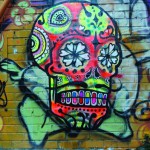
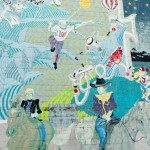

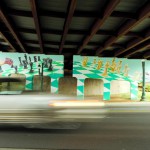
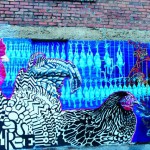
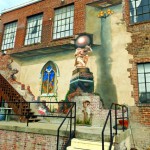


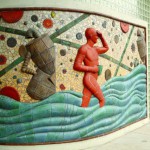




Hey folks at Sims Futon. It would be nice if you acknowledged the other artist involved in painting your mural. The panel of your dogs chasing the witty rabbit was my design and the ghostly Ginger in the sky was also mine. Scott did paint the dog band on the lower portion. I also was the designer and painter of your mule , Fred. Sincerely, Sharon S. Nicol
Scott Herring and Sharon Nicol we’re staying at my house while the Sims Gallery mural was being planned and painted. I can attest that Sharon did at least half of the design and implementation. She also coined the houndstooth comment. She should get equal credit for the creation of the mural.